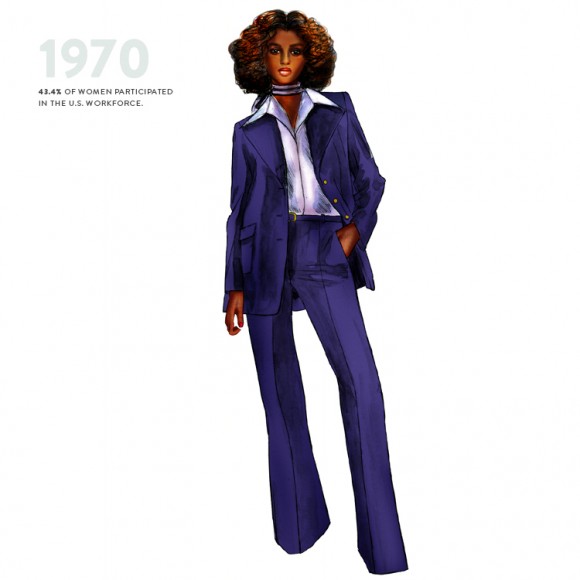Our Workwear, Ourselves: How Women’s Workwear Has Evolved

What we wear to work can say a lot about our status, our confidence, and how we wish to be perceived. The evolution of women’s workwear styles over the past 100+ years reflects changing attitudes and beliefs about women and power in the United States, as well as the struggles women have gone through to make it this far. While it might seem as if anything goes for women at work these days, a look at women leaders in different industries reveals there is still a social code to crack.
Stand Out – but in a Good Way
Women who lead express their confidence by finding their own unique styles rather than conforming to what their male counterparts wear. At Facebook, founder Mark Zuckerberg wears his signature gray T-shirt, jeans, sneakers, and hoodie while COO Sheryl Sandberg’s uniform consists of tailored dresses and elegant separates. You won’t catch her at work in sneakers or an old-school, matching suit. This is Sandberg’s way of “leaning in” to navigate the new territory of women’s workwear by embracing her femininity. However, there’s a line between professional femininity and overt sexuality she chooses not cross. Her necklines tend to stop just below her collarbones.
The Higher the Office, the Greater the Scrutiny
Sometimes you just can’t win. During the presidential race in 2007, candidate Hillary Clinton’s black pantsuits were referred to as “a desexualized uniform.” However, when she tried to spice things up with a subtle, V-shaped neckline, a Pulitzer-Prize-winning female journalist called attention to the slightest hint of cleavage in a way that sparked unwanted global media attention.
In this historic year in which Hillary Clinton has become the first female presidential nominee of a major party, MBA@UNC, UNC Kenan-Flagler Business School’s online MBA program, presents a brief illustrated history of women’s workwear in the United States. It represents the journey toward equal rights and opportunity:
1910
23.4 percent of women participated in the U.S. workforce.

The American Ladies’ Tailors’ Association created the “suffragette suit” to free women from the hobble skirt, which was hemmed so tightly at the ankles that it made it hard for women to move freely. Legislators at the time sought to enforce mandatory wearing of corsets and a hemline no shorter than one inch off the ground.
1920
21 percent of women participated in the U.S. workforce.

In 1925, as the 19th Amendment ratified women’s right to vote, French fashion designer Coco Chanel’s menswear-inspired cardigan style wool jackets gave women fewer frills and more room to move and eat without being restricted by a corset.
1930
22 percent of women participated in the U.S. workforce.

French designer Marcel Rochas took women’s desire to wear suits and pants a step further by creating the pantsuit in 1932.
1940
25.4 percent of women participated in the U.S. workforce.

The “wartime silhouette” dominated the 1940s because of fabric rationing and sparked new styles such as “the military look.” During World War II, close to 350,000 women served in the U.S. armed services.
1950
33.9 percent of women participated in the U.S. workforce.

By 1947, Christian Dior had reintroduced a “fit and flare” style, and the “New Look” burst forth with a celebration of fabric and a return to feminine fashion after the uniformity of the war years.
1960
37.8 percent of women participated in the U.S. workforce.

The 1960s were characterized by ensemble dressing, casual suits, and the shortest hemlines in history. The Equal Pay Act of 1963, the Civil Rights Act of 1964, and a presidential executive order in 1967 that banned discrimination on the basis of sex in hiring and employment sparked a period of androgynous style.
1970
43.4 percent of women participated in the U.S. workforce.

Women’s unisex clothing in this period reflected the struggle for equal rights and career advancement and the awareness that being perceived as sexual objects diminishes women’s authority.
1980
51.5 percent of women participated in the U.S. workforce.

The menswear-inspired power jacket put the focus on large shoulder pads and loose-fitting pants to take the focus off gender and create a feeling of authority. Women’s role in management jobs nearly doubled from 20 to 36 percent.
1990
57.5 percent of women participated in the U.S. workforce.

Workplace strides gave women the confidence to emphasize themselves and dress in simple cuts in muted palettes of black, cream, and beige.
2000
59.5 percent of women participated in the U.S. workforce.

In today’s entrepreneurial, casual workplaces, women are learning to dress in ways that represent their businesses or organizations and express their own personal brands. By 2015, women were launching more than 1,200 new businesses in the U.S. every day and generating $1.4 trillion in revenue annually.
And workwear continues to evolve.

